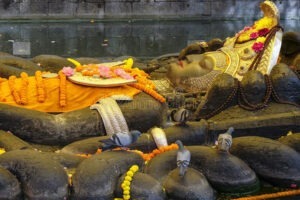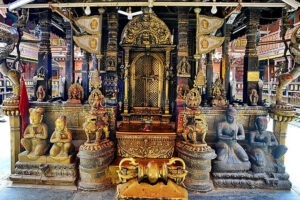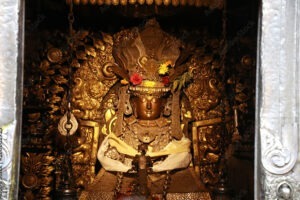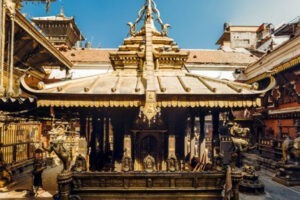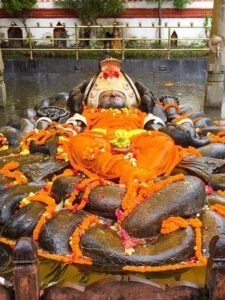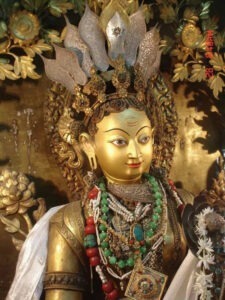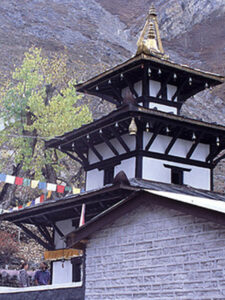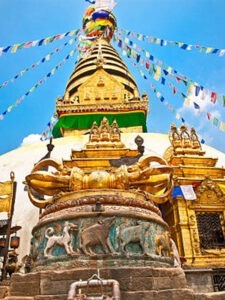The 5 most beautiful temples to see in Nepal
Mannat Voyages has selected for you the five must-see temples in Nepal, these sacred buildings that preserve the country’s ancestral local customs and architectural heritage.
The Golden Temple in Patan
The Golden Temple is a Buddhist monastery located north of Patan’s Durbar Square, dedicated to Sakyamuni Buddha. The Golden Temple or Hiranya Varna Mahavihar has a three-storey pagoda, rich carvings and ornaments, such as a giant prayer wheel, a bronze vajra and a small monastery.
Patan is now absorbed into the metropolitan area of Kathmandu, the capital of Nepal. The Golden Temple is said to have been founded in the 12th century under King Bhaskardev. Patan is therefore the former royal city. Patan, a Newari word, in Nepali Lalitpur, the “City of Artisans” is the second largest city in Nepal.
It used to be the capital and a city of art, located 6 kilometers south of central Kathmandu, but the two cities are now joined, the only visible demarcation nowadays being the Bagmati River.
The Durbar Square is a collection of UNESCO World Heritage Sites, in what is known as the Kathmandu Valley.
The buildings surrounding the square were heavily damaged, with some collapsing, by the 2015 Nepal earthquake.
Muktinath in Mustang
The sacred temple of Muktinath is located at an altitude of 3710 meters above sea level in the Mustang district of Nepal. The Muktinath Temple is a very famous holy place for Hindus and Buddhists all over the world. This temple is located on the route of the famous Annapurna Circuit, just below the Thorong-La Pass mountain.
This temple is built in the pagoda style and is considered a symbol of the religious similarity between Hinduism and Buddhism. Muktinath is one of the oldest temples of Vishnu. There are two holy water ponds in front of Muktinath Mandir Laxmi Kunda and Saraswati Kunda. Locals believe that by taking a bath in these ponds, ‘negative karma’ is removed. Hindus call this shrine Muktikshetra, which means place of salvation, and Buddhists call this place Chumig Gyatsa, which means place of 108 waterspouts. Near Muktinath, there is a Jwala Mai temple with three eternal flames inside the Gompa.
According to Hinduism, this is the place where Lord Vishnu obtained salvation from the curse of Brinda. He is therefore worshipped here as Muktinath, the lord of salvation. Devotees believe that this shrine has risen on its own. The temple is surrounded by 108 cow faces through which holy water is poured.
The Muktinath temple is one of the eight shrines of Vishnu. The Muktinath temple is also one of the 108 Vaishnava shrines. The snow-covered Annapurna range forms the backdrop to this temple. The Upper Mustang region and the Tibetan plateau lie to the north of the temple.
Budanilkantha in Kathmandu
The Budhanilkantha statue of the Hindu god Vishnu, located about 10 kilometers from the center of Kathmandu at the foot of Shivapuri Hill, is the largest and most beautiful stone sculpture in Nepal. It is also the most enigmatic.
Carved from a single block of black basalt of unknown origin, the Budhanilkantha statue is 5 meters long and lies in a recessed water tank (representing the cosmic sea) 13 meters long. Called Sleeping Vishnu, or Jalakshayan Narayan, the statue depicts the deity reclining on the coils of the cosmic serpent Shesha (Shesha is the multi-headed eternal king of the serpentine deities known as Nagas, and is also the servant of Vishnu). Vishnu’s legs are crossed and the eleven heads of Shesha surround his head. Vishnu’s four hands hold objects that symbolize his divine qualities: a chakra or disc (representing the mind), a conch shell (the four elements), a lotus flower (the universe in motion) and the club (primordial knowledge).
Budhanilkantha literally means “old blue throat” and how it got this name is fascinating, as the excellent Rough Guide to Nepal explains:
“The name Budhanilkatha has been a source of endless confusion. It has nothing to do with the Buddha (budha means ‘old’, but that doesn’t stop the Buddhist Newars – a particular sect of Nepalese Buddhists – from venerating the image). The real question is why Budhanilkantha (literally ‘Old Blue Throat’), a title that unmistakably refers to Shiva, has been linked here to Vishnu. The myth of Shiva’s blue throat, popular in Nepal, tells how the gods churned the ocean of existence and inadvertently released a poison that threatened to destroy the world. They begged Shiva to save them from their mistake and he agreed by drinking the poison. With his throat burning, the great god flew to the mountain range north of Kathmandu, struck the mountainside with his trident to create a lake, Gosainkund, and quench his thirst – suffering no lasting side effects, except for a blue spot on his throat. It is popularly believed that the water in the sleeping Vishnu tank comes from the Gosainkund, and the Shaivas claim that a reclining image of Shiva can be seen under the waters of the lake during the annual Shiva festival in August, which may explain this association.
Indreshwar Mahadev in Panauti
One of the largest Newari pagoda-style wooden temples in Nepal, the three-tiered Indreshwar Temple dates back to 1294. It took nearly 90 years to complete. It has been renovated several times over the centuries and has survived numerous earthquakes, including the devastating 2015 Gorkha earthquake. Its architectural strength derives – perhaps in part – from its northeast cornerstone, which is said to be the cursed disembodiment of the divine Ahalya.
Although the story of Ahalya varies considerably from text to text, she is generally described as the most beautiful woman in the world, created by the god Brahma himself. According to the most common version of her fate, she was married to Gautama Maharishi, but was deceived and seduced by Indra, the king of heaven. For her infidelity, she was turned to stone.
Whatever the origin of the temple’s longevity, it dominates the confluence of the Rosi and Punyamati rivers and serves as both a village landmark and an important spiritual centre for the small village of Panauti – by some estimates one of the oldest towns in Nepal.
Regardless of its age, Panauti’s architecture displays distinct cultural influences from Bhaktapur and is one of the best preserved centres of Newari craftsmanship, exemplified nowhere more majestically than in the Indreshwar Temple. Unfortunately, because the town lies off the main east-west highway through Nepal, Panauti is often overlooked except by dedicated pilgrims.
The Newari people have inhabited the Kathmandu Valley for many centuries. Although they are the sixth largest ethnic group in the country, their cultural contributions – particularly in the field of architecture – continue to be highly emblematic of the wider Nepalese aesthetic. The wood and brickwork of the Indreshwar Temple is a particularly fine example of Newari craftsmanship, and the small museum next to the temple is full of other fascinating examples of the region’s artistic heritage, from copperware to wood carvings, statuary and more.
Swayambhunath in Kathmandu
The Swayambhunath Stupa stands out from far, perched on a remote hill to the west of Kathmandu. Like many sacred sites, access is not easy. It takes courage and willpower to climb the 365 steps from the foot of the hill to the jewel of Kathmandu, Swayambhunath. But don’t worry, you’ll get encouragement from a myriad of monkeys along the way! This is why the Swayambhunath Stupa is nicknamed the Monkey Temple. Be careful though, these monkeys are not tame, so it’s best to avoid looking them in the eye so they don’t feel threatened.
Although Swayambhunath is a Buddhist place, Hindu devotees also make the trip to worship this sacred stupa. Thus, Buddhists and Hindus alike join in circumambulation around the hill. The most frequented prayer path by devotees is of course the one around the Swayambunath stupa itself.
This dome topped by a cone gives the impression of following the visitor with his eyes. And for good reason, the eyes of Buddha have been painted on each side of the stupa! Did you know that Buddha has three eyes? The stupa has the usual two eyes that every human being has. These are surmounted here by a third eye. This eye is said to serve as a portal to spread Buddha’s thoughts to the celestial beings!
From the Swayambhunath Stupa, it is not only the stupa that is visible but also small temples and stalls selling local products. But what fascinates many travelers is the breathtaking view of the Kathmandu valley and the city below!
The legend of Swayambhunath: It is said that Kathmandu was once submerged under the waters of a huge lake. In the middle of this lake was a large lotus. The Bodhisattva Manjusri is said to have come to pay homage to this “self-creation” (Swayambhu in Nepalese). In order to make this sacred place accessible to the faithful, he would then have the water drained from the lake. This is how the Kathmandu Valley was created! The lotus is said to have turned into a hill and its flower into a stupa; hence the name Swayambunath Stupa…
Despite the quantity of magnificent temples in Nepal, here is our selection for you. Don’t hesitate to ask your Mannat Travel Expert for more information or to organize your trip.



